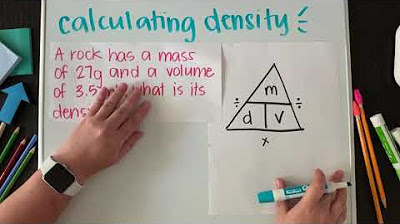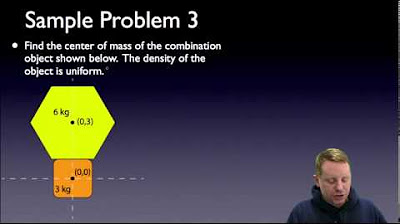Center of Mass of a thin wire
TLDRThis educational video script explores the concept of finding the mass and center of mass of a linear wire with a variable density function. The wire spans the interval from 1 to 2 on the x-axis with a density function of 8/x^3. Through integration, the script calculates the moment about the origin and the total mass, revealing the center of mass to be at one and one-third, closer to the left end due to the decreasing density as x increases. The explanation is clear, demonstrating how the distribution of mass affects the center of mass.
Takeaways
- 📏 The problem involves finding the mass and center of mass of a linear wire with a specific density function over an interval.
- 📚 The interval for the wire is between 1 and 2 on the x-axis.
- 📉 The density function, delta, is given as 8 divided by x cubed (8/x^3).
- 🔍 The center of mass is calculated using the formula for the moment about the origin, which involves integrating x times the density function over the interval.
- 📘 The integral simplifies to 8 times x to the power of -2 (8x^-2), which is then evaluated from 1 to 2.
- 📊 The antiderivative of the simplified expression is found to be -8/x, and the moment about the origin is calculated to be 4.
- 📐 The total mass of the system is found by integrating the density function over the interval, yielding an antiderivative of -4/x^4 and a total mass of 3.
- ⚖️ The center of mass, x bar, is determined by dividing the moment about the origin by the total mass, resulting in 4/3.
- 🔄 The center of mass is closer to the left-hand side of the interval due to the decreasing density function as x increases.
- 📈 The density function's behavior explains why the center of mass is shifted towards the lower end of the interval.
- 📝 The video concludes with a brief summary of the findings and a teaser for the next video, which will calculate the center of mass of a thin plate.
Q & A
What is the interval on the x-axis for the linear wire described in the script?
-The interval for the linear wire is between 1 and 2 on the x-axis.
What is the density function delta(x) of the wire?
-The density function delta(x) is given by 8/x^3.
What formula is used to calculate the moment about the origin for the wire?
-The formula used to calculate the moment about the origin is the integral from a to b of x times the density function delta(x) dx, where in this case a is 1 and b is 2.
How is the antiderivative of the density function 8/x^2 found?
-The antiderivative of 8/x^2 is found by adding 1 to the exponent, resulting in -8/x.
What is the moment about the origin (m naught) for the wire?
-The moment about the origin is calculated as 4, which is obtained by evaluating the antiderivative from 1 to 2.
How is the total mass of the system found?
-The total mass of the system is found by integrating the density function from 1 to 2, which results in 3.
What is the formula to find the center of mass x bar of the wire?
-The center of mass x bar is found by dividing the moment about the origin (m naught) by the total mass.
What is the calculated center of mass x bar for the wire?
-The calculated center of mass x bar is 4/3, which is closer to the left-hand side of the interval.
Why is the center of mass closer to the left-hand side of the interval?
-The center of mass is closer to the left-hand side because the density function decreases as x increases, indicating more weight on the left side.
What is the significance of the density function in determining the center of mass?
-The density function is significant because it shows how the mass is distributed along the wire, affecting the location of the center of mass.
Outlines
📚 Calculating the Center of Mass for a Linear Wire
This paragraph discusses the process of finding the mass 'm' and the center of mass 'x bar' of a linear wire with a given density function 'delta' over an interval on the x-axis. The wire is situated between 1 and 2 on the x-axis, and the density function is given as 'eight over x cubed'. The solution involves calculating the moment about the origin and the total mass of the system by integrating the density function over the interval. The moment about the origin is calculated as 4, and the total mass 'm' is found to be 3. The center of mass 'x bar' is then determined by dividing the moment by the total mass, resulting in a value of 4/3, indicating that the center of mass is closer to the left side of the wire.
Mindmap
Keywords
💡mass
💡center of mass
💡linear wire
💡interval
💡density function
💡integral
💡moment about the origin
💡antiderivative
💡total mass
💡units
💡decreasing density
Highlights
The task is to find the mass and center of mass of a linear wire with a given density function.
The wire lies on the interval between 1 and 2 on the x-axis.
The density function, delta, is given as eight over x cubed.
The center of mass is calculated using the moment about the origin formula.
The moment about the origin is the integral of x times the density function from 1 to 2.
The integral simplifies to eight times x to the power of negative second.
An antiderivative of the density function is found to calculate the moment about the origin.
The moment about the origin is evaluated from 1 to 2, resulting in 4.
The total mass of the system is found by integrating the density function from 1 to 2.
The antiderivative for the total mass calculation is found and evaluated.
The total mass of the system is determined to be 3.
The center of mass, x bar, is calculated by dividing the moment by the total mass.
The center of mass is found to be at one and one-third.
The density function decreases as x increases, affecting the center of mass position.
The center of mass is closer to the left-hand side due to the decreasing density function.
The next video will calculate the center of mass of a thin plate described in a different problem.
Transcripts
Browse More Related Video

Triple integrals 2 | Double and triple integrals | Multivariable Calculus | Khan Academy

Center of Mass & Centroid Problems - Calculus

2021 AP Calculus AB Free Response #1 Solutions (First Administration)

AP Physics C: Momentum, Impulse, Collisions & Center of Mass Review (Mechanics)

Calculating Density

AP Physics 1 - Center of Mass
5.0 / 5 (0 votes)
Thanks for rating: